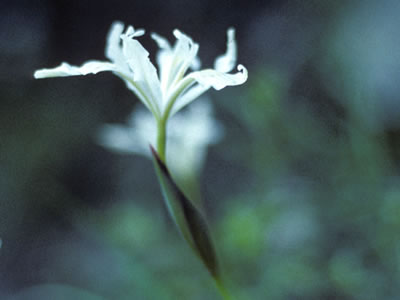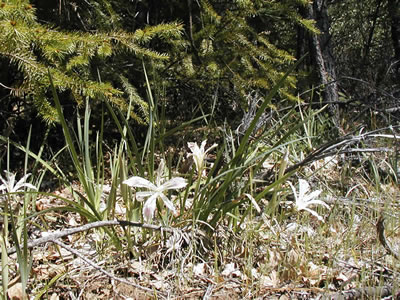Our Native Irises: Pacific Coast Irises
Iris tenuissima ssp. tenuissima: Long Tube Iris
The long tube iris occurs in northern California.
Iris tenuissima ssp. tenuissima has yellow, creamy white or white flowers. The sepals are widely spreading, not arching downward but rather flat in appearance with veins lavender, reddish-brown or dark yellow. The signal has a yellow patch near the base. The petals are the same color as the sepals but with much lighter colored veins. The petals are erect and slightly spreading. The inflorescence has one to two flowers. The flowering stalks are shorter than the attending leaves. The 1 to 3 stem leaves are green, free from the stem except near their base. The leaves are light green, upright and slightly reflexed, basal with a pink to red base, from branching rhizomes with fibrous roots, occurring in compact, dense clumps.
Iris tenuissima ssp. tenuissima is found growing in sunny to lightly shaded oak/pine woodlands.
For More Information
Iris tenuissima ssp. purdyiformis: Long Tube Iris
The long tube iris occurs in northern California.
 This subspecies of long tube iris is separated from subspecies tenuissima in that the leaves are attached to the flowering stalk for most of their length, only separating at their tips. Photo by Carol Wilson, The Genus Iris.
This subspecies of long tube iris is separated from subspecies tenuissima in that the leaves are attached to the flowering stalk for most of their length, only separating at their tips. Photo by Carol Wilson, The Genus Iris.
Iris tenuissima ssp. purdyiformis has yellow, creamy white or white flowers. The sepals are widely spreading, not arching downward but rather flat in appearance with veins lavender, reddish-brown or dark yellow. The signal is a yellow patch near the base. The petals are the same color as the sepals but with much lighter colored veins. The petals are erect and slightly spreading. The inflorescence has one to two flowers. The flowering stalks are shorter than the attending leaves. The 3 to 4 stem leaves are green flushed with pink, free from the stem only at their tips. The leaves are light green, upright and slightly reflexed, basal with a pink to red base, from branching rhizomes with fibrous roots, occurring in compact, dense clumps.
Iris tenuissima ssp. purdyiformis is found growing in sunny to lightly shaded oak/pine woodlands.





